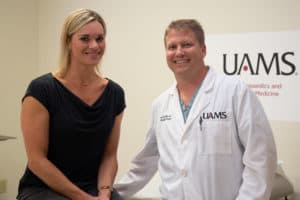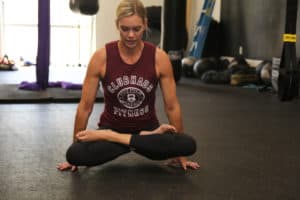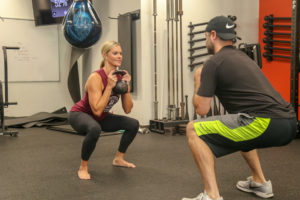View Larger Image

Grobmyer climbs aerial silk.
Personal Trainer Back to Pain-Free Activity Following Hip Replacement Surgery
| One week after her hip replacement surgery, Jessie Grobmyer found herself back in the gym teaching classes. The personal trainer looked forward to being active in her recovery.
“I couldn’t stay cooped up. I had to get back to living life,” she said.
Grobmyer has lived an active lifestyle since she was a child. The 39-year-old is a personal trainer at Clubhaus Fitness on Rebsamen Park Road in Little Rock. She is also an aerial silk performer and teaches Pilates, spin classes and circuit training.
A few years ago, she started feeling pain in her hip that slowly became worse over time. She had a minor surgery, but it did little to relieve her pain.
“It got to the point I could hardly do any exercises,” Grobmyer said. “The pain occupied 100 percent of the time. Every step was painful. It was even difficult to grocery shop or walk my dog.”
Grobmyer initially thought the pain was coming from the soft tissue. When she realized the pain was in her joint, she says she was surprised and terrified.
“I felt I was too young to need a hip replacement,” Grobmyer said. “It seemed like an extreme option and I wondered if I would ever be the same after having that surgery.”
This year, the pain became unbearable. So Grobmyer set an appointment with Paul Edwards, M.D., a hip-and-knee surgeon at UAMS and an assistant professor in the UAMS College of Medicine’s Department of Orthopaedic Surgery. Edwards removed the damaged right hip joint and replaced it with an artificial implant.
The first month was challenging. But it wasn’t long before Grobmyer could see progress.
“I went from having to use a walker, to a few days later walking stairs with no pain. A few days later, I was doing squats. I was back to doing just about everything within three months.”
During her six-month follow up he showed Grobmyer her before and after x-rays.

Grobmyer with Paul Edwards, M.D., a hip-and-knee surgeon at UAMS and an assistant professor in the UAMS College of Medicine’s Department of Orthopaedic Surgery.
“You can see the severe arthritis here and that the cartilage was worn out,” Edwards said. “That’s why you were having such a difficult time teaching your classes. In the post-surgery image, you can see there is no bone-on-bone rubbing because of the replacement, eliminating pain and inflammation. It looks beautiful.”
“It feels beautiful,” Grobmyer said. “I’m not having any pain at all. I have good range of motion. I didn’t think I would ever be able to do the full lotus, but I can now with no problems.”
The lotus is a yoga pose where an individual sits with her legs crossed, each foot on the opposite thigh. It requires a lot of flexibility in the hips.

The full lotus pose requires a lot of flexibility in the hips. Grobmyer demonstrates she has full range of motion after her surgery.
Physicians and researchers in the UAMS Department of Orthopaedic Surgery published a peer-reviewed study in the Journal of Arthroplasty last year that may help guide surgeons in counseling patients who have hip replacement surgery about yoga-related activity.
“It’s interesting because you’re a testament to that paper and some of the information we gained from doing that study,” Edwards said. “Here at UAMS we pride ourselves on not only taking care of our patients, but also taking the next step to understand future treatment options available to patients.”
Grobmyer would tell her former self not to wait so long before getting the surgery.
“I couldn’t have asked for a better doctor,” she said. “Dr. Edwards was so encouraging and positive and obviously very skilled. He came highly recommended and I’m grateful it all worked out.”
